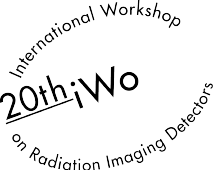Speaker
Description
Dosepix is a hybrid pixel detector with 16x16 pixels at a pitch of 220µm based on the time-over-threshold measurement principle of Timepix. It has been developed for dosimetry of ionizing radiation, especially for personal dosimetry in pulsed X-ray radiation fields as available active personal dosimeters can fail at very high dose rates or short pulse durations. The pixel size is a compromise between the necessary small size of the pixel for high dose rates, reasonable energy resolution and the area needed for the electronics in the pixel cell. The pixel cell circuitry features a charge sensitive preamplifier which is connected to a leading edge discriminator. Dosepix features a register for analog threshold adjustments among pixels. The length of the digital output of the discriminator is the time--over--threshold (ToT). A clock signal for ToT measurement is generated in the ASIC by a phase-locked-loop. The ToT is determined for each event in a binary counter. The content of the ToT counter is copied to the ToT latch for energy channel assignment. The ToT counter is then reset to zero so that the next arriving pulse can be processed. The energy channel to which the ToT value has to be assigned is identified by the binning-state machine. It sequentially compares 16 stored digital thresholds with the measured ToT value. The 16 pre-defined time-over-threshold (ToT) values in each pixel serve as borders of the 15 energy channels (ToT channels) and as low threshold of the 16th energy channel. The 16 thresholds can be defined individually for every pixel. If the measured ToT value is above or equal to a certain digital threshold and if it is below the threshold of the next energy channel, the event is assigned to a 16-bit binary counter (energy bin register) associated with the energy channel. This way, a histogram of the number of detected events with energy depositions in the predefined energy intervals (ToT intervals) is accumulated in each pixel. Readout proceeds one column at a time (while the others remain sensitive) to avoid dead-time for the whole detector. As the spectra of deposited energies are very similar for different high photon energies, several detectors with adapted filters have to be used in order to determine personal dose equivalents correctly up to 1.5 MeV. Personal dose equivalents can be calculated from the measured energy histograms as a linear combination of the number of counts with conversion factors determined with a Monte-Carlo-simulation. First measurements at the German Metrology Institute PTB indicate, that personal dose equivalents can indeed be measured accurately with photon counting pixel detectors such as Dosepix, even at very high dose rates. Figure 1 shows the deep dose response (measured/true dose) as function of the average photon energy for perpendicular irradiation and +-60 degrees angle of incidence. One can see that Dosepix measures the doses with the required accuracy (green band).
In this talk we will review the functionality of Dosepix and present first measurements of personal dose equivalents with a setup with 3 Dosepix detectors.
